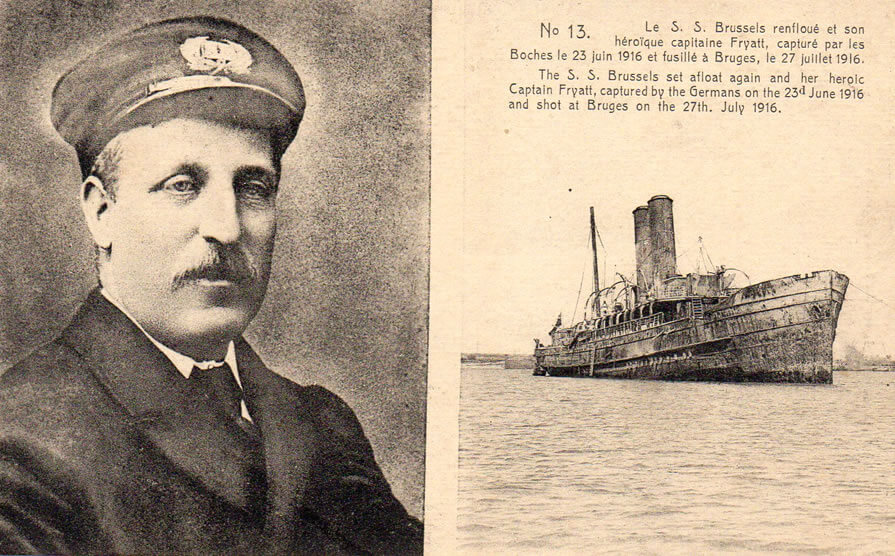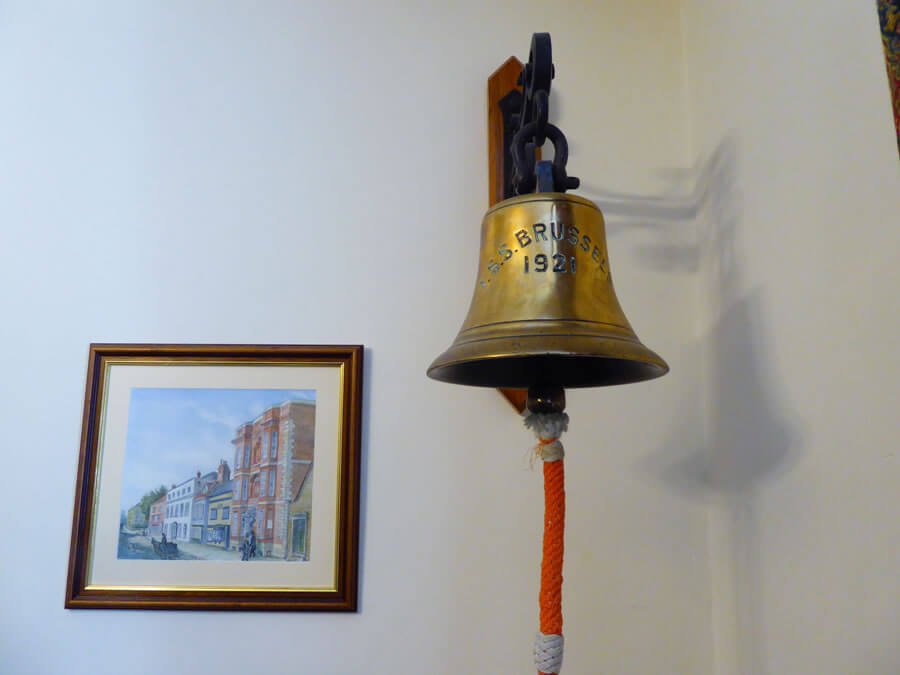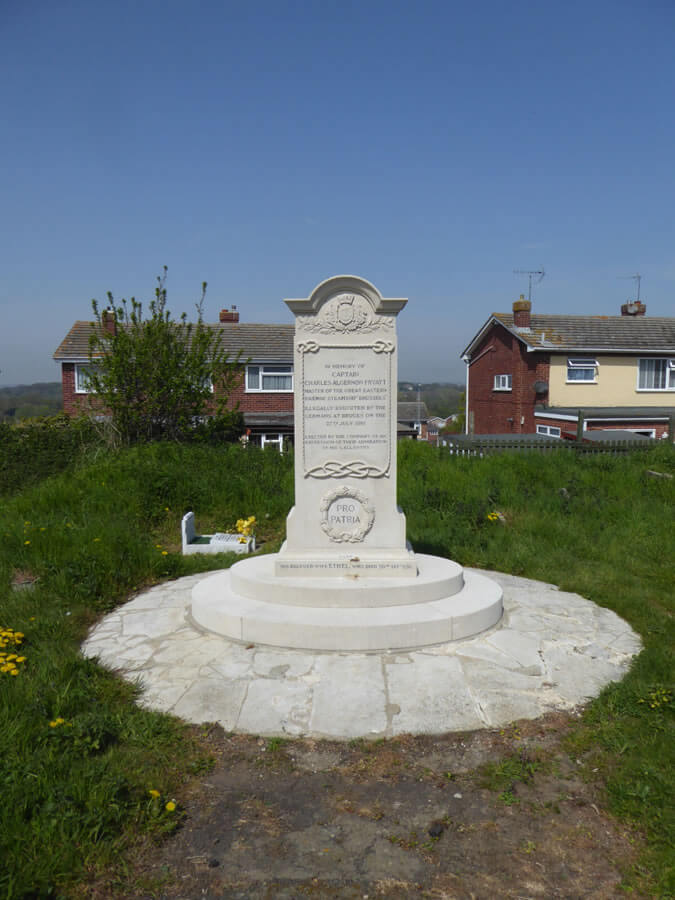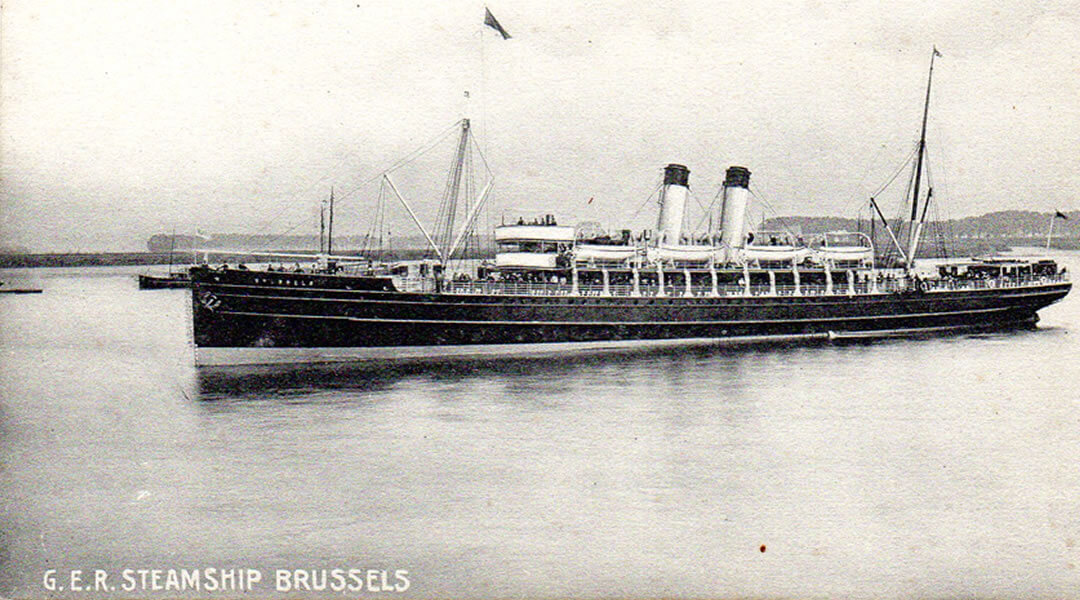Charles Algernon Fryatt was born at Southampton on 2nd December 1871, the second son of Charles and Mary. Charles senior held a first mate’s certificate and after many years travelling the world obtained employment with the Great Eastern Railway Company at Harwich in the 1880s. The family moved into one of the company’s houses in Adelaide Street close to the port area known as Parkeston Quay.
On leaving school the young Charles followed into his father’s footsteps joining the Great Eastern Railway Company’s passenger ship Norwich on 23rd August 1887 as a deck boy. On 27th February 1889 he joined Colchester as an able seaman on £1-5-0d per week sailing between Harwich and Antwerp going on to sail on Harwich, Ipswich, Peterborough, Chelmsford and Norwich. At this time the company’s vessels were dry-docked twice yearly usually on the river Humber and it is likely that is was on one of these dry-docking that young Charles met his wife Ethel for on 2nd November 1896 the couple were married at the Parish Church, Kingston upon Hull.
Like most shipping companies of that period the company would select young seamen that they thought had the ability to study for and pass their various certificates of competency. Charles was chosen going on to successfully obtain his second mates home trade certificate in June 1900 being promoted to that position sailing on the steamer Brandon. By 1907 Charles held a mates home trade certificate sailing in that position on the passenger vessel Cambridge earning £2-5-0d per week going on to obtain a masters home trade certificate, his first command being the cargo steamer Newmarket sailing between Harwich and Rotterdam earning £4-5-0d per week.
With the country now at war Newmarket was requisitioned on 8th October 1914 and taken over by the Royal Navy along with seven of her crew. As a replacement for Newmarket the G.E.R. chartered from the Great Central Railway Company the cargo steamer Wrexham crewing her with most of the crew from Newmarket including Captain Fryatt.
The Netherlands remained a neutral country throughout the First World War allowing the G.E.R. to maintain some form of service between Harwich and the Dutch ports of Rotterdam and Hook of Holland though at some periods Harwich was closed to commercial traffic with Tilbury becoming the British terminus. The Harwich vessels operating these services were Brussels, Colchester, Cromer, Wrexham and briefly Copenhagen. These vessels becoming increasingly in danger having to navigate through unmarked channels keep a constant lookout for mines and German submarines. The first report of problems from German submarines came from Captain Francis Laurence the then master of Colchester on 11th December 1914. On 2nd March 1915 Wrexham under Captain Fryatt was chased some 40 miles before reaching the safety of the Dutch coast. For this Captain Fryatt was awarded a gold watch in recognition of his courage and skill full seaman ship with special complements being paid to the engine room personnel. With Wrexham having a maximum speed of only 12 knots and hostilities increasing the G.E.R. decided the vessel was too slow and her charter terminated, Captain Fryatt was transferred to the passenger steamer Brussels.
On 10th February 1915 the Admiralty issued secret orders to the masters of all British ships briefly stating that “No British merchant ship should ever tamely surrender to a submarine, but should do its upmost to escape. If a submarine comes up suddenly close ahead with obvious hostile intentions, steer straight at for it at utmost speed, altering course as necessary to keep it ahead. The submarine will probably dive, in which case your sip will have ensured its safety, as she will be compelled to come up astern of your ship”.
On only Captain Fryatt’s third voyage on Brussels after leaving Wrexham on 28th March 1915 the ship was steaming from Harwich to Hook of Holland, some eight miles from the Maas Buoy a German submarine was sighted. U33 under the command of Commander Gansser signaled to Brussels to stop, Captain Fryatt obeyed Admiralty orders recording in the official log book “1.10 pm. Sighted submarine two points on starboard bow. I altered my course to go under his stern. He turned round and crossed my bows from starboard to port. When he saw me starboard my helm he started to submerge and I steered straight for him. At 1.30pm his periscope came up under my bows, port side, about six feet from the side and passed astern. Although a good lookout was kept I saw nothing else of him. I was steering a E by S course at the time of sighting him, and brought my ship to a north easterly course. When I was over the top of him the latitude was 51.08 N and 3.41 E. Back in Harwich Captain Fryatt became known as “the Pirate Terror”. Harwich Borough Council mayor, Edward Saunders, presented Master, Charles Fryatt, mate, Charles Stiff and Chief Engineer, Robert Smith with commendations for their bravery and duty to their country that day.
Various masters over the forthcoming months continued to report harassment from German submarines. On 1st April 1916 Cromer, under Captain Beeching, rammed and sank a German submarine, he was later awarded a Distinguished Service Cross.
At 23.00 on 22nd June 1916 Brussels set sail from Hook of Holland loaded with mail, 100 refugees, 1 passenger, 45 crew a Marconi Wireless Operator and a Trinity House pilot. Whilst still I the New Waterway a rocket was sent up into the night sky from ashore, with hindsight it was probable a signal to say the enemy was in the area. About 12 miles out passed the Maas Buoy a small vessel was detected, it signaled in morse the letter “S”, Captain Fryatt was correctly concerned, mate William Hartnell continued to sweep the sea with his night glasses as Brussels continued on her voyage at full speed. A small vessel ahead was spotted so Brussels switched on her navigational lights for one minute. Fifteen minutes later Brussels was surrounded by five German torpedo boats, Brussels was ordered to stop. Captain Fryatt had no alternative but to surrender but not before the Admiralty secret papers and diplomatic bags had been destroyed in the ships furnaces. Germans swarmed on board with revolvers and grenades in their hands rounding up the officers and ratings. A German flag was hoisted with the new crew steaming the ship to Zeebrugge. Arriving in Zeebrugge crowd watched to see the new German war prize dock. Six hours later when the tide was high Brussels set off on the last leg of her journey to Bruges. Here the crew were marched to the town hall where they were imprisoned, Captain Fryatt and William Hartnell were held in solitary confinement where they underwent intense interrogation. The crew were held there for two nights, on the third day they were herded in to a cattle truck and taken by train to Ghent for another overnight stay. In the morning they boarded a special passenger train which took them to Ruhleben. Captain Fryatt was assured at Bruges the crew would not come to any harm though the men would be detained for the duration of the war, the stewardesses would be repatriated. Before the train arrived at Ruhleben the stewardesses were taken off and taken by another train to Holzminden being repatriated home the following month.
On 27th July 1916 Charles Algernon Fryatt stood before a court at Bruges charged as follows:
“Although he was not a member of a combat force, he had made an attempt, on 28th March 1915 to ram German submarine U33 near the Maas Buoy”
Had the master either at the interrogation or at the trial stated he was acting under Admiralty instructions, in heading for the enemy in order to escape capture, the court would not have condemed him, the German code giving him protection to an enemy in these circumstances. All Captain Fryatt would say was “I have done nothing wrong”. At 16.00 the court found Charles Algernon Fryatt guilty and ordered him to be shot. William Hartnell was allowed to stay in the master’s cell until 18.00 when the guards arrived to take Charles away. He was taken to a courtyard, tied to a post then after a brief conversation with a German paster was blindfolded and shot. Thirty minutes later a telegram arrived from Berlin ordering the sentence to be postponed.
Although the Netherlands was a neutral country it was an open secret that many spy rings operated there and the G.E.R. steamers were heavily involved with them having direct telegraph links with Whitehall using codes referring to wild flowers blooming and other curious phrases. Following the capture of Brussels several spy rings were rounded up by the Germans.
Lord Claud Hamilton, chairman of the G.E.R. at his retirement party in 1923 admitted he had ordered the ship’s masters to make every effort to ram and sink German submarines.
The Germans went on to rename their war prize Brugge using her as a submarine depot ship. On 5th October 1918 under the threat of British invasion Brugge was scuttled at the entrance to Zeebrugge harbour as a block ship to protect the submarine base. With the war over the wreck was raised during August 1919, taken in tow to Antwerp in December and handed back to the British Government on 26th April 1920 at Antwerp. During July a representative from the Imperial War Museum inspected the wreck had been plundered by the Belgians only recovering a brass port light for their museum.
The wreck was sold at auction at Antwerp on 17th August 1920 to the Dublin & Lancashire Shipping Company for £3,100. The money was donated to a charity to commemorate Charles Fryatt, this took the form of the Memorial Hospital at Harwich. The Great Eastern Railway Company had already received £51,000 from the ship’s insurers. Mrs Fryatt was awarded a pension of £250 annually from the G.E.R. and a further £100 annually from the British Government.

The wreck arrived at Goole via Hull on 10th December 1920 to be rebuilt by the Goole Shipbuilding Company but no work was carried out there. Brussels was then towed to Henry Robb Shipyard, Leith where she arrived on 13th March 1921 for rebuilding, work included constructing a new bridge deck and flying bridge. Her machinery was completely overhauled, work included re-tubing two of her boilers. She was recommissioned as a cattle and sheep carrier (700 heads) for the Dublin & Lancashire Steamship Company entering service between Dublin and Preston on 7th September 1921 having sailed from the repair yard on 1st September.
Brussels was then sold to British & Irish Steam Packet Company when sailings to Liverpool were included in her sailing schedule. Between 9th September 1922 and 7th April 1923 Brussels was in dry-dock at the Langton Graving Dock, Liverpool for another major rebuild. In line with the new company’s naming policy in April before departing she was renamed Lady Brussels.
The ship remained active making her last sailing from Preston to Dublin via Liverpool on 13th April 1929. Following a short lay up Lady Brussels arrived at Port Glasgow on 19th April 1929 for breaking up. Her Dedication to Captain Fryatt plate had been removed and donated to the Mercantile Marine Institute at Liverpool.
After the war the family and the British Government wanted the body repatriated to England. In the presence of the deceased brother William Fryatt and colleague William Hartnell, at the quiet graveyard in Bruges, grave diggers set to work on 4th July 1919 to exhume coffin number 29. The lid was removed allowing the observers to identify the body as Charles Algernon Fryatt, still wearing his master’s uniform, his boots by his legs and cap on his chest. The coffin lid was replaced and the entire coffin placed into a new larger coffin. After lying in state at Bruges the body was taken to Antwerp and loaded on to the British destroyer H.M.S. Orpheus. Calling at Zeebrugge on route the coffin was landed at Dover on 7th July where it was off loaded on to a special carriage (this carriage was on display at Harwich Town Station between 5th and 14th July 2019) where it remained over night before heading for Charing Cross station. On 8th July 1919 the coffin was taken by gun carriage was ceremoniously paraded through the streets of London to St Paul’s Cathedral accompanied by fellow masters as pall bearers, Captains Barren, Goodey, Laurence and Stiff. Following the service the coffin was taken to Liverpool Street Station and loaded on to a special train to Dovercourt Bay Station. On its arrival at 16.00 it was conveyed in a full Naval, Military and Civic procession with a Navy band from nearby Shotley to All Saints Churchyard, its final resting place. At the graveside a short service was conducted including the singing of the sailor’s hymn “Abide With Me”. On 16th June 1920 Lord Claud Hamilton unveiled a memorial stone at the grave donated by the Great Eastern Railway Company.
In Jasper National Park, Alberta, Canada a mount was named Mount Fryatt, some 16 Km from Mount Edith Cavell in his commemoration. A peak was also named Brussels Peak.
In April 1950 the Harwich Borough Council Council purchased a 10” ship’s bell inscribed Brussels 1921 from Captain C. Glover, Lythan St Annes, Lancashire for £15. It was believed by the Harwich Borough Council to have been the replacement bell following the rebuilding of Brussels.


